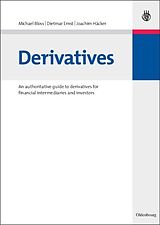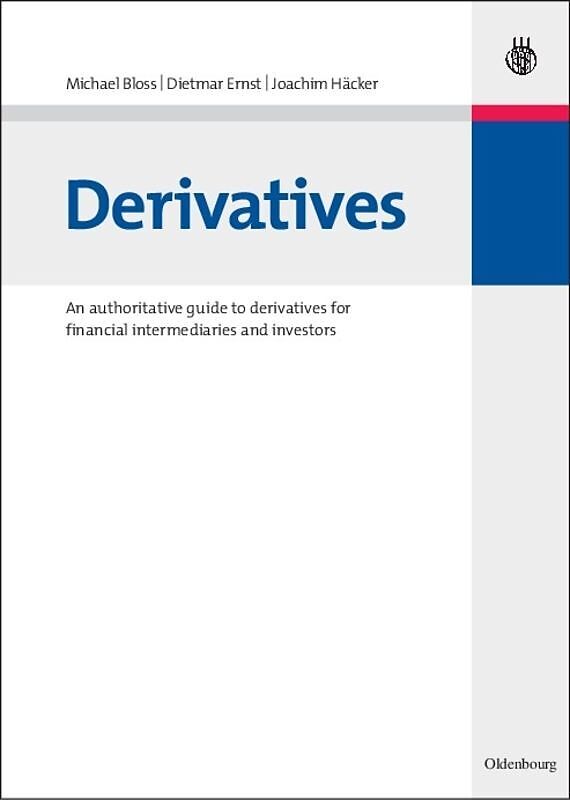Derivatives
Einband:
Fester Einband
EAN:
9783486586329
Untertitel:
An authoritative guide to derivatives for financial intermediaries and investors
Autor:
Michael Bloss, Joachim Häcker, Dietmar Ernst
Herausgeber:
De Gruyter Oldenbourg
Auflage:
1. Auflage
Anzahl Seiten:
304
Erscheinungsdatum:
07.04.2008
ISBN:
3486586327
Options and futures are among the most important tools in today's financial world. While the book focuses on the contracts traded on derivatives exchange - options and futures - we will also scrutinize the OTC-markets and exotic deals. Due to its didactic overall set-up, this book serves as both, a manual for practitioners and a classical textbook for students.
Options and futures are among the most important tools in todays financial world. While the book focuses on the contracts traded on derivatives exchange, options and futures, we will also scrutinize the OTC-markets and exotic deals. Due to its didactic overall set-up, this book serves as both a manual for practitioners and a classical textbook for students. The book is written in co-operation with Eurex by academic orientated investment banking professionals. It is applicable to either the finance student or the business person.
Autorentext
Michael Bloss, CFE ist Direktor der Commerzbank AG und des Europäischen Instituts für Financial Engineering und Derivateforschung (EIFD). Er lehrt an der European School of Finance (ESF) der HfWU sowie als Visiting Professor an der University of Vancouver Island, Canada. Als Kommentator des Geschehens an den internationalen Finanzmärkten ist er u. a. regelmäßig auf N24 und dem Deutschen Anlegerfernsehen (DAF) zu sehen. Als Buchautor beschäftigt er sich mit Themen des Financial Engineering: Der Bewertung und Konstruktion von Finanzinstrumenten, deren Einsatz und Umsetzung.
Zusammenfassung
Sehr gut einsetzbar in englischsprachigen Bachelor-Veranstaltungen. Prof. Dr. Bernd Müller, Hochschule Niederrhein
Leseprobe
1 How derivative exchanges and markets are structured (p. 1-2)
This chapter deals with the following questions:
1. How have derivatives e changes developed historically?
2. What are derivatives?
3. Why are most derivatives contracts currently traded standardized?
4. What functions do derivative e changes fulfill?
5. Who are the market participants at derivative e changes?
6. How are derivative e changes organized?
7. What other basic definitions are needed to understand derivative e - changes and markets?
8. "Bursa Mater et Magistra" – or: What is a sensible trading approach at the derivatives e change?
1.1 A history of derivative exchanges
The financial derivative transactions we know today originated in commodity futures trading at derivative exchanges. These instruments were created as a safeguard against price risks.
As early as two-thousand years B.C., the first forms of derivatives markets emerged in India. Faced with unertainty in regards to situations in different world regions and economic change, people transacted rudimentary futures contracts to lock in the prices of goods delivered by sea. From the Middle Ages we know of futures contracts in England and France. These were mainly commodity futures on goods to be delivered from Asia several months later. Again, the motive for these transactions was to lock in prices. Around 1630, the Netherlands experienced intense trading of options on tulip bulbs (later known as the Tulip Mania). Similar to the New Economy we faced at the turn of the century, it led to the forming of bubbles: due to excessive demand, tulip bulbs became increasingly expensive, resulting in an upward price spiral. When investors began to reap their profits and get rid of their investments, it instigated a selling surge causing the price of tulip bulbs to collapse. Most investors suffered losses of more than 90 percent. In Asia, a brisk trade in rice and silk was going on at the same time. The futures exchange there was called "Dojima Rice Market". Today, it is considered the very first futures market worldwide, located in Osaka, Japan.
The triumphant rise of the Chicago Board of Trade as the "mother of all futures exchanges" set in after 1848 (it was founded on April 3 of that year). This was the first time in history that standardized futures contracts were listed and traded. In 1989, the Chicago Butter and Egg Board was established. Originally, only butter and eggs could be traded at this exchange. As the range of products widened over the years, the board was renamed Chicago Mercantile Exchange (CME) in 1919. In 2007, CME announced its intention to acquire the Chicago Board of Trade (CBoT).
The question that remains now concerns the causes in the rising popularity of futures contracts. The rapid increase of US-American public debt, along with the abolishment of fixed exchange rates (with contracts introduced on May 16, 1972 on the International Monetary Market IMM), resulted in a new economic environment accompanied by greater volatility. In response to the volatility concern, the first financial futures contract – an interest future – was introduced in Chicago in the 1970s. This marked the birth of financial futures trading. In 1972, the first foreign-currency futures on the seven major global currencies were traded. The first contracts on the S&,P 500 were introduced on the CME in 1982. In 1988, the German Futures Exchange DTB ("Deutsche Terminbörse") was founded, merging in 1998 with the Swiss SOFFEX, to consolidate into what today is known as Eurex. In 1992, the CME's GLOBEX Trading System (a computer-based trading platform) was put into service.
Inhalt
1;Preface;6
2;Authors;8
3;Introductory Note;10
4;List of Abbreviations;12
5;Contents;14
6;1 How derivative exchanges and markets are structured;22
6.1;1.1 A history of derivative exchanges;22
6.2;1.2 What are derivatives?;23
6.3;1.3 Standardized derivatives trading Why is it common?;25
6.4;1.4 What functions do derivative exchanges fulfill?;27
6.5;1.5 Who are the market participants at derivative exchanges?;28
6.6;1.6 How are derivative exchanges organized?;29
6.7;1.7 Understanding derivative exchanges and markets what do we need to know?;30
6.8;1.8 Bursa Mater et Magistra : How can reasonable trading behaviour at derivatives exchange be described?;33
7;2 Set-up and structure of derivatives exchanges the Eurex case study;36
7.1;2.1 How do electronic exchanges work?;36
7.2;2.2 What is the market-maker principle?;37
7.3;2.3 How is trading carried out at Eurex?;38
7.4;2.4 What products can be traded at Eurex?;40
7.5;2.5 What does the term clearing mean?;41
7.6;2.6 What categories of order specifications exist?;42
7.7;2.7 What expiration dates are used by Eurex?;45
8;3 Options Conditional derivatives;46
8.1;3.1 What are options and how do call options and put options differ?;46
8.2;3.2 What types of options do exist?;48
8.3;3.3 Options trading;49
8.4;3.4 What are weekly options?;51
8.5;3.5 What are Low-Exercise-Price Options?;51
8.6;3.6 Closing out a derivative position;52
8.7;3.7 Roll-over;53
9;4 The pricing of options;54
9.1;4.1 How are option prices determined in theory?;54
9.2;4.2 What value drivers influence option prices?;57
9.3;4.3 What do the so-called Greeks mean?;61
9.4;4.4 What is the put-call parity all about?;65
9.5;4.5 How are option prices determined under the Black-Scholes model?;66
9.6;4.6 How are option prices determined under the Binominal model?;67
9.7;4.7 Tradable option prices;70
10;5 Strategies involving options;72
10.1;5.1 What are the four basic options trading strategies all about?;72
10.2;5.2 How to hedge with options;80
10.3;5.3 What option combinations are common?;81
10.4;5.4 How to set up a strategy for options trading;89
10.5;5.5 What is the significance of market opinion?;90
11;6 Futures unconditional…

Leider konnten wir für diesen Artikel keine Preise ermitteln ...
billigbuch.ch sucht jetzt für Sie die besten Angebote ...
Die aktuellen Verkaufspreise von 6 Onlineshops werden in Realtime abgefragt.
Sie können das gewünschte Produkt anschliessend direkt beim Anbieter Ihrer Wahl bestellen.
Loading...
Die aktuellen Verkaufspreise von 6 Onlineshops werden in Realtime abgefragt.
Sie können das gewünschte Produkt anschliessend direkt beim Anbieter Ihrer Wahl bestellen.
| # | Onlineshop | Preis CHF | Versand CHF | Total CHF | ||
|---|---|---|---|---|---|---|
| 1 | Seller | 0.00 | 0.00 | 0.00 |
